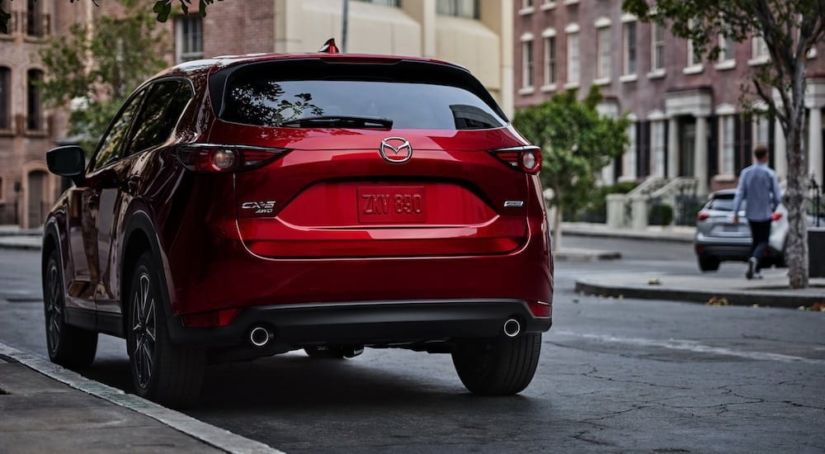It is common to consider an SUV when its time to purchase your new vehicle. Unlike small cars, an SUV can offer more passenger and cargo room without compromises in performance. Compared to larger trucks, SUVs can also be preferable since you get more of a car-like experience with better interior features, a smoother ride, and conveniences. Since SUVs come in many different sizes from compact to full-size, it is easy to see why many individuals strongly consider SUV models in the first place. When you get serious about an SUV, it can be difficult to know how much you should pay. Just like any other vehicle, SUVs come in many different price points. Whether you are looking at Toyota, Ford, Chevy, or Mazda models, these vehicles get divided up into different trims, packages, and general prices. Setting a budget for yourself before going out and considering any specific SUV brand or model is of utmost importance, especially for Mazda SUVs. A carefully thought out budget will keep you from spending more than you have to put towards a new SUV comfortably. A budget will also let you see what you can realistically afford before signing on the dotted line at the dealership. In other words, a good budget is like a guide: it ensures you have planned and prepared financially when considering your new vehicle. How much of a budget should you set? That depends on your financial situation and what you’re looking for in a new vehicle.
Finances
More than anything else, a good SUV budget depends on your financial situation. We would all like to be able to afford something that costs more than we realistically can set aside. Even with different financing options like auto loans and car leases, it is helpful to be realistic about your expectations. A reasonable budget needs to be accurate for what is comfortable for you based on both your income and expenses.
This means you have to take into account your job stability, monthly income, and the amount of debt you already have. If you decide to go for an auto loan, most loan providers will be checking this information, so you can get a head start automatically.
Resist the temptation to paint a rosy picture of your finances. If you have an excellent credit history, little to no debt, and a stable job, this is a great situation to be in. If you do not meet these criteria, however, all is not lost. Many options exist for those with less than perfect credit although you may have to set the budget lower or explore different financing options before you consider different models.
Different SUV Options
Beyond how much you can afford, it also helps to know the different price ranges that SUVs have since this will help you determine what type to consider in the first place. Even though most SUVs have very similar basic layouts, specifications, and options, there are some significant differences between certain makes and models that will affect the final price tag.
The first and most simple difference between SUVs is the size. Just like trucks, many SUVs span the entire range from small sedans to full-size pickups. In this range, you will find small compact SUVs that can hold around five or six people all the way up to full-size, family-friendly versions meant for more people and cargo. In general, the larger an SUV model is, the higher the starting price will be. This depends on many different things including the manufacturer and specific model you are checking out.
Beyond the size, most differences in price come down to performance and features. When you look under the hood, the size and power of the engine help set the baseline price. More powerful engine options like V-6 and V-8 powerplants will increase the final price tag automatically. The option of two- or four-wheel-drive systems is also a possible added expense since many standard SUVs come with two-wheel drive only.
Though more powerful engines and drivetrains can be more expensive, they may be well worth the extra cost depending on your needs. For example, some drivers need more horsepower and torque for different purposes such as towing or hauling more cargo. If you plan on driving on challenging terrain or in bad weather, all-wheel or four-wheel-drive can also be more reliable since it offers better traction compared to rear-wheel-drive only vehicle.
Finally, the little details of the final price come down to features and accessories in the SUV. All SUVs, regardless of their size and starting price, will always have certain features that come standard and others that are upgrades. What you need or want will depend on the type of overall driving experience you want, especially for the interior.
The best approach is to take some time to list out all of your needs in an SUV before setting on a budget. Consider what you want in terms of overall performance. More horsepower and torque usually mean a higher priced SUV. If you are looking for fuel efficiency, however, a smaller, more affordable engine option with a four-cylinder setup can be certainly more than adequate.
List out all the different conveniences and safety features you would also like in an SUV. This is an area where some sacrifices might be necessary if you want to keep your budget low. If you have to prioritize, make sure the SUV comes with all the safety features you want before any luxury perks.
Settling On A Budget
Once you have taken the steps of looking at your financial situation and listing out your “must haves” for an SUV, you’ll be ready to set a realistic budget. With this number in mind, take the time and research the different possibilities that fit within this budget. If possible, look a little below and above the budget as well just to see how the options differ. While you can change your budget anytime you want, it is best to stick with it as much as possible to keep yourself in the best possible financial position.
With solid research of models and options and a thoughtful budget, it can be easy to find a great SUV at a price point even when you’re trying to save some extra money.



